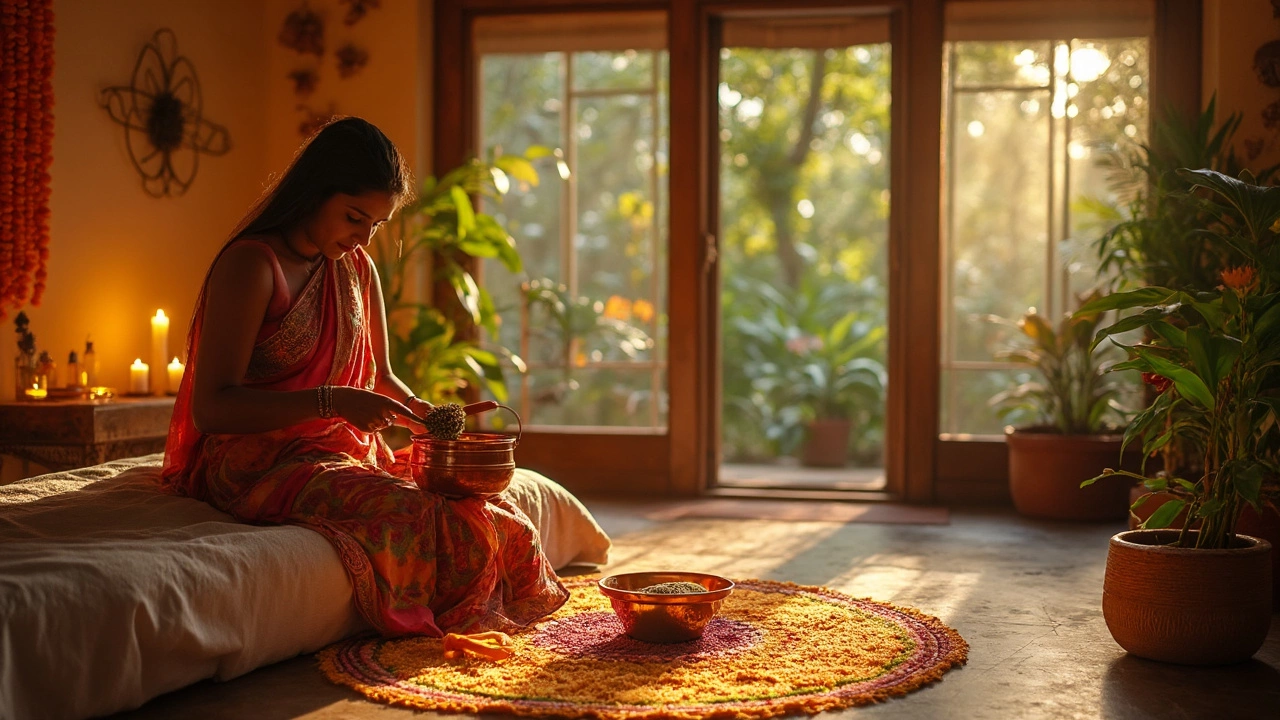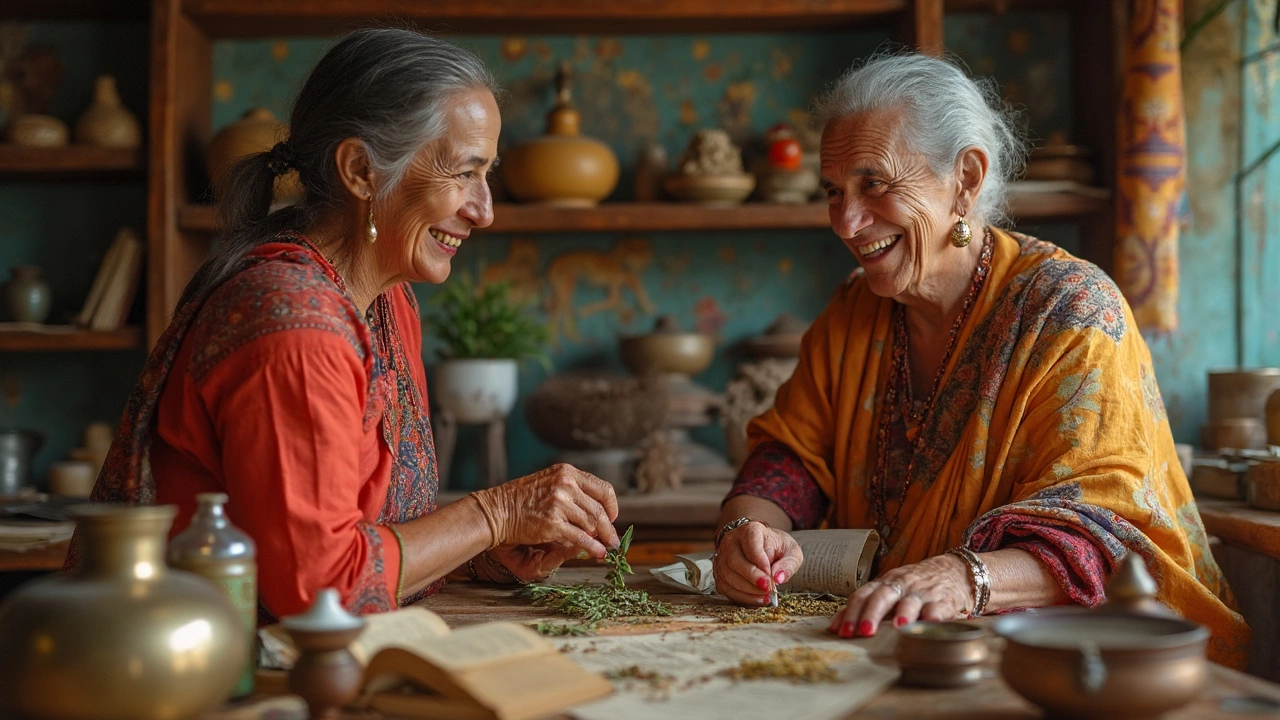
You’ve probably heard of deep tissue or Swedish massage, but Ayurvedic massage is on a whole different page. Instead of being just about sore shoulders, it’s about getting your whole system in balance. Picture this: warm, herbal oils gliding across your skin, hands moving in a way that’s matched to what your body needs that day. Every move, every herb, every oil is picked for a reason.
The cool part? It doesn’t use one-size-fits-all routines. If you struggle with sleep, stress, or even joint pain, the therapist tailors the whole session for you. This massage comes out of Ayurveda, a system that’s been around for thousands of years. It’s all about keeping your body and mind in sync so you feel good, inside and out.
- The Roots of Ayurvedic Massage
- How Does It Actually Work?
- What Are The Main Benefits?
- Tips to Get Started (Even at Home)
The Roots of Ayurvedic Massage
Ayurvedic massage has real history—it’s not some new-age idea. This method comes straight from Ayurveda, the traditional system of medicine that’s been practiced in India for over 3,000 years. Back then, it wasn’t just about relaxing. People used it to keep their bodies in check, the same way you might use vitamins or a daily walk now. It’s actually laid out in ancient texts like the Charaka Samhita and the Sushruta Samhita, which are the Ayurvedic guides for health.
The word ‘abhyanga’ pops up a lot when you’re talking about Ayurvedic massage. That just means a full-body oil massage. These oils aren’t picked at random. Traditionally, they’re made with herbs blended for different needs—think sesame oil for warming up your joints, or coconut oil if you tend to run hot or get skin rashes. Even the time of day matters in Ayurveda—many people practice abhyanga first thing in the morning.
Ayurvedic massage goes hand-in-hand with the whole concept of balancing ‘doshas’. The doshas—Vata, Pitta, and Kapha—are just categories for your body’s natural tendencies. Out of balance? That’s when you start feeling off, whether it’s trouble sleeping or constant tension in your shoulders. Massage is one simple tool for keeping these doshas steady.
| Key Elements | Description |
|---|---|
| First recorded use | Over 3,000 years ago in India |
| Main goal | Keep the body's doshas balanced |
| Traditional oils | Sesame, coconut, and herbal blends |
| Classical texts | Charaka Samhita, Sushruta Samhita |
This isn’t a “just for the wealthy” treatment either. In India, abhyanga is part of everyday life for lots of families, right alongside things like yoga and home remedies. Even today, parents will often massage their kids to help them grow stronger and sleep better. For adults, it’s seen as both self-care and real preventative health care.
If you’re after results more than just relaxation, Ayurvedic massage lays out the blueprint. It’s time-tested, constantly practiced, and rooted in more than just “feeling good.” It’s about long-term health, not just quick fixes.
How Does It Actually Work?
Ayurvedic massage does more than just press muscles—it's a full system based on understanding your dosha (body type) and picking the right oil and method for you. There are three main doshas in Ayurveda: Vata, Pitta, and Kapha. Each one reacts differently to touch, oil, and pressure, so therapists use a quick body and lifestyle assessment to figure out your dosha before starting.
For Ayurvedic massage—often called abhyanga—the therapist usually uses warmed herbal oils. These oils aren’t random; they’re selected based on your body’s needs. For example, sesame oil is common for dry skin and Vata types, while coconut oil is cooling and good for Pitta folks. Therapists spend time massaging the oil in long, slow strokes, usually working toward your heart to help blood flow and get lymph moving.
- Main Steps of an Ayurvedic Massage:
- Personal dosha assessment
- Choosing and warming the right herbal oils
- Applying oil all over—head to toe
- Massage with different movements for joints, muscles, or energy points
- Resting to let oil soak in
- Shower or steam to finish off
The science behind this isn’t just tradition. Several studies found an average 15% drop in stress measurements (like blood pressure and cortisol) after regular abhyanga over 4 weeks. People also reported better sleep, higher energy, and fewer aches. Here's a quick breakdown of some benefits seen in research projects:
| Benefit | Reported Improvement |
|---|---|
| Reduced stress | Up to 15% drop in cortisol |
| Better sleep | 73% felt deeper rest |
| Less muscle pain | 65% reported lighter joints |
| Improved mood | 60% noticed better mood |
If you’re wondering if you have to fly to India for this, good news—you can find trained therapists all over the world. Just make sure they know how to match the massage and oil to you, not just follow a basic routine. This customization piece is what makes Ayurvedic massage different from anything you’ll get at a regular spa.

What Are The Main Benefits?
People don’t go for an Ayurvedic massage just for some pampering—there’s a real payoff, and it’s backed by how long this practice has stuck around. When you look at what this type of massage can do for you, it's actually pretty surprising how far it goes beyond a simple back rub.
- Ayurvedic massage oils hydrate the skin deeply, making it smooth and helping with dry patches or roughness. The oils used—like sesame or coconut—are packed with nutrients that your skin drinks right up.
- Stress relief is a big one. Regular sessions lower stress hormones in the body, messing less with your mood and sleep. Some clinics say their clients report up to 30% better sleep patterns after just a few sessions.
- It can kick your blood flow into higher gear. That means your muscles get more oxygen and toxins are flushed out faster, which is great for your energy levels and recovery after workouts.
- If your joints crackle or ache, this kind of massage is gentle but effective. It supports flexibility and even helps people with mild to moderate arthritis feel looser and more mobile.
- Some evidence shows that people with anxiety or headaches feel relief after sticking with Ayurvedic massage. It’s a combo of the oils, the pressure points, and the overall chill factor.
Here’s a quick table showing how people say they benefit from ayurvedic massage compared to regular massage therapy:
| Benefit | Ayurvedic Massage | Regular Massage |
|---|---|---|
| Deep skin hydration | Yes | Usually not |
| Targeted stress & anxiety relief | High | Moderate |
| Uses herbal oils | Always | Rarely |
| Holistic health focus | Yes | Sometimes |
| Customized for individual needs | Yes | Mostly general |
Massage therapists often say their regulars notice more stable moods, fewer body aches, and even a better immune system. Pretty wild for something that feels this relaxing.
Tips to Get Started (Even at Home)
Thinking of trying Ayurvedic massage yourself but not ready for a trip to a wellness clinic? No big deal. You honestly don’t need fancy gear or special skills. Here’s the scoop on what you can do right at home to get some of the same benefits.
- Pick the right oil: Ayurveda says different oils fit different body types. Sesame oil is a classic for most people, especially if you tend to get cold easily. Coconut oil works if you usually run hot or live somewhere warm. If you’re unsure, start with sesame—it’s the most widely recommended.
- Warm it up a bit. You want the oil just warmer than your skin—not hot enough to burn. A few seconds in a microwave or over a bowl of hot water does the trick.
- Apply with intention. Pour a small amount of oil into your palm, rub your hands together, then use gentle, circular motions over joints and long, straight strokes over limbs. Spend extra time where you feel tension. Don’t rush it.
- Give yourself 15–20 minutes if you can. Let the oil soak in before you shower. This downtime isn’t just to let your skin absorb the oil—it also helps your mind chill out.
- Be consistent. Doing this once is nice. Doing it a couple of times a week? Way better. Regular Ayurvedic massage can help your skin, your mood, and how your body feels overall.
Don’t forget little things, like using an old towel to protect your bathroom from oil spills. And don’t scrub too hard—the goal is comfort, not muscle-wrangling.
| Oil Type | Best For | Common Benefits |
|---|---|---|
| Sesame | Most body types, especially Vata | Warming, nourishing, stress relief |
| Coconut | Pitta types, hot climates | Cooling, soothes irritation, hydrates |
| Mustard | Kapha types, cold/damp weather | Stimulation, circulation, fights sluggishness |
Lots of people use playlists with soft music, but honestly, even a few quiet minutes before bed can make this feel pretty special. If you have allergies, always do a patch test with your oil first. And if you’re dealing with anything major—like a skin condition or serious injury—check with your doctor before you start.





Rohan Talvani
I am a manufacturing expert with over 15 years of experience in streamlining production processes and enhancing operational efficiency. My work often takes me into the technical nitty-gritty of production, but I have a keen interest in writing about medicine in India—an intersection of tradition and modern practices that captivates me. I strive to incorporate innovative approaches in everything I do, whether in my professional role or as an author. My passion for writing about health topics stems from a strong belief in knowledge sharing and its potential to bring about positive changes.
view all postsWrite a comment